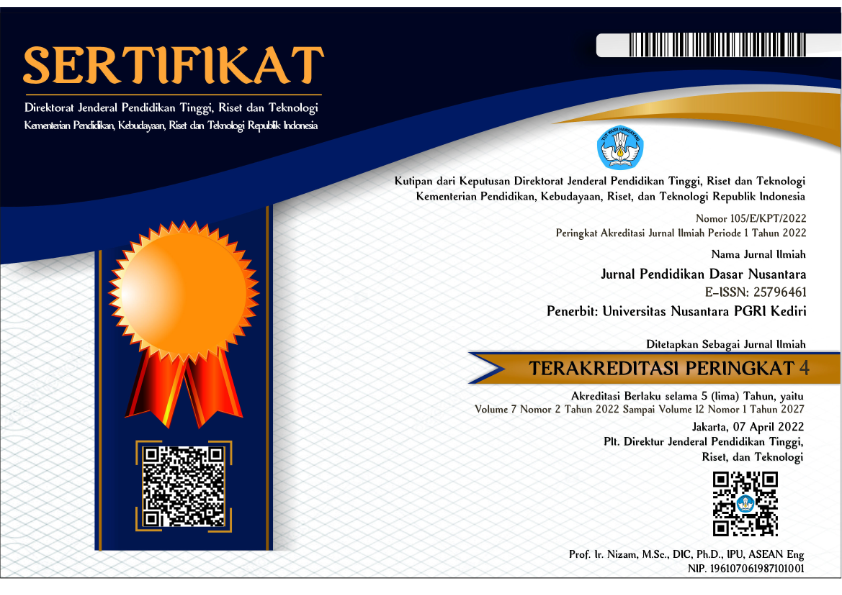Elementary school learning system in Trenggalek during the covid 19 pandemic
DOI:
https://doi.org/10.29407/jpdn.v7i2.16177Keywords:
elementary school learning media during the Covid Pandemic 19Abstract
This article is based on finding out systematic learning in elementary school during the COVID-19 pandemic in the Trenggalek area. The main target points are teachers, guardians, and elementary students regarding the process of teaching and learning activities during the covid-19 pandemic. The method used in this study is a qualitative method, namely the method used by asking for some information from several parties concerned directly in accordance with the facts. Giving various questions and statements to the person concerned to receive the answer (Sugiyono, 2014: 142). And the data collection method used is a questionnaire. The data analysis method uses the Miles & Hubberman (2014) model which includes data reduction, presentation, verification, and conclusions. This study uses interview techniques, so that valid data sources can be obtained. Checking the validity of the data using triangulation of sources, namely teachers, students, and guardians of students. This information was obtained not only from 1 or 2 sources, but from several elementary schools in rural and urban areas such as SDN 2 Margomulyo, SDN 1 Tasikmadu, SDN 2 Sawahan, SDN 1 Ngadisoko, and SDN 1 Trenggalek. The selection of resource persons must also be appropriate, who are good at conveying information which can be proven to be true, which is an important reference in the preparation of this article. The quality of the learning media used to complete important points in order to improve the quality of the article
Downloads
References
Arikunto, Suharsimi. (2014). Basics of Educational Evaluation (Revised Edition). Jakarta. Earth Literature.
Daheri, M., Juliana, J., Deriwanto, D., & Amda, AD (2020). The Effectiveness of WhatsApp as an Online Learning Media. Journal of Basicedu, 4(4), 775–783.
Dewi, WAF (2020). The Impact of COVID-19 on the Implementation of Online Learning in Elementary Schools. Educational: Journal of Educational Sciences, 2(1), 55–61.
Harjasuganda, D. (2008). Positive Self-Concept Development in Elementary School Students as the Impact of Application of Feedback in Physical Education Learning Process. In the Journal of Basic Education Number, 9(8), 4-5.
Herliandry, LD, Nurhasanah, Suban, ME, & Heru, K. (2020). Learning Media Transformation During the Covid-19 Pandemic Period Journal of Educational Technology, 22(1), 65–70.
Irawan, E., Arif, S., Hakim, AR, Fatmahanik, U., Fadly, W., Hadi, S., ... & Hidayati, N. (2020). Higher Education During a Pandemic: Transformation, Adaptation and Metamorphosis Towards the New Normal. Zahir Publishing.
Kusuma, DA (2020). The Impact of the Implementation of Online Learning on Students' Self-Regulated Learning in Geometry Courses During Distance Learning During the Covid-19 Pandemic. Theorems: Mathematical Theory and Research, 5(2), 169-175.
Lase, D. (2019). Education in the Industrial Revolution Era 4.0. SUNDERMANN: Scientific Journal of Theology, Education, Science, Humanities and Culture,1(1),28-43.
Mar'ah, NK, Rusilowati, A., & Sumarni, W. (2020). Changes in the Online Learning Process for Elementary School Students. Proceedings of the UNNES Postgraduate National Seminar.
Marsiding, Z. (2021). The Effectiveness of Using Zoom Media on Learning During the Covid-19 Pandemic Scientific Journal of Pranata Edu, 2(1), 33–39.
Moleong (2011) CHAPTER III RESEARCH METHODS A.Research Design
Mulyasa. (2015). Teachers in 2013 Curriculum Implementation. Bandung: Rosda
(http://www.dostoc.com/does/1991556/4_270228) (Downloaded 23 August 2020)
Oemar Hamalik, Teaching and Learning Process (Jakarta: Rosdakarya Youth 2016) 30
Ramadhani, SP, & Supena, A. (2020). Parents' and Teachers' Perceptions of Learning During the COVID-19 Pandemic Period on 8-Year-Old Speech Disorder Children at Madrasah Ibtidayah. Journal of Basicedu, 4(4), 1267–1273.
Revindasari, F. (2015). Development of anmoodle-based quiz and material management system interactive and communicative (Doctoral dissertation, State University of Malang).
Riani, N., & Handayani, NS (2020). The Impact of Librarian Work Stress During the Covid-19 Pandemic n College Library Services. Fihris: Journal of Library and Information Science,15(1),97-114.
Santoso, DH, & Santosa, A. (2020). Covid-19 in Various Perspective Review. LPPM Mercubuana.
Sugiono Educational Research Methods Quantitative, Qualitative and R&D Approaches
(Bandung: Alfabeta, 2013)
Sulfemi, W. B. (2019). Teacher's Pedagogic Ability.
Zainab (2021) Trenggalek Magazine, equitable distribution of learning in Trenggalek.
Downloads
Published
Issue
Section
License
Authors who publish with this journal agree to the following terms:
- Copyright on any article is retained by the author(s).
- The author grants the journal, the right of first publication with the work simultaneously licensed under a Creative Commons Attribution License that allows others to share the work with an acknowledgment of the work’s authorship and initial publication in this journal.
- Authors are able to enter into separate, additional contractual arrangements for the non-exclusive distribution of the journal’s published version of the work (e.g., post it to an institutional repository or publish it in a book), with an acknowledgment of its initial publication in this journal.
- Authors are permitted and encouraged to post their work online (e.g., in institutional repositories or on their website) prior to and during the submission process, as it can lead to productive exchanges, as well as earlier and greater citation of published work.
- The article and any associated published material is distributed under the Creative Commons Attribution-ShareAlike 4.0 International License

































